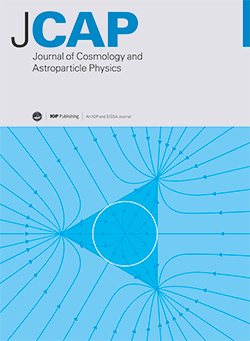暗能量融化观测约束的最优参数化
IF 5.3
2区 物理与天体物理
Q1 ASTRONOMY & ASTROPHYSICS
Journal of Cosmology and Astroparticle Physics
Pub Date : 2025-06-24
DOI:10.1088/1475-7516/2025/06/054
引用次数: 0
摘要
在观测分析中,时变暗能量通常通过其状态方程w(z)的一般参数化来建模,该方程通常使用两个自由参数{w0, wa}来跨越作为红移函数的广泛行为范围。然而,这种广泛的行为范围只能近似地捕捉任何给定的暗能量微物理理论的动力学。一种补充方法是使用目标参数化,以更高的精度对特定类别的动态暗能量进行建模。聚焦于解冻暗能量的类别,我们量化并比较了19种通用和有针对性的参数化可以捕捉物理驱动的解冻精粹理论动力学的精度。我们发现,从w的帕德维尔膨胀中得到的目标参数化是这些参数化中最可靠的,它可以精确地重建w(z)、膨胀历史H(z)和宇宙学参数,如H0和Ωm,适用于广泛的微物理理论。本文章由计算机程序翻译,如有差异,请以英文原文为准。
Optimal parameterizations for observational constraints on thawing dark energy
Time-varying dark energy is often modeled in observational analyses through generic parameterizations of its equation of state w(z), which typically use two free parameters {w0, wa} to span a broad range of behaviors as a function of redshift. However, this broad range of behaviors can only approximately capture the dynamics of any given microphysical theory of dark energy. A complementary approach is to use targeted parameterizations designed to model specific classes of dynamical dark energy with greater precision. Focusing on the class of thawing dark energy, we quantify and compare the precision with which nineteen generic and targeted parameterizations can capture the dynamics of physically motivated thawing quintessence theories. We find that a targeted parameterization derived from a Padé expansion of w is the most reliable of these, producing accurate reconstructions of w(z), the expansion history H(z), and cosmological parameters such as H0 and Ωm for a broad range of microphysical theories.
求助全文
通过发布文献求助,成功后即可免费获取论文全文。
去求助
来源期刊

Journal of Cosmology and Astroparticle Physics
地学天文-天文与天体物理
CiteScore
10.20
自引率
23.40%
发文量
632
审稿时长
1 months
期刊介绍:
Journal of Cosmology and Astroparticle Physics (JCAP) encompasses theoretical, observational and experimental areas as well as computation and simulation. The journal covers the latest developments in the theory of all fundamental interactions and their cosmological implications (e.g. M-theory and cosmology, brane cosmology). JCAP''s coverage also includes topics such as formation, dynamics and clustering of galaxies, pre-galactic star formation, x-ray astronomy, radio astronomy, gravitational lensing, active galactic nuclei, intergalactic and interstellar matter.
 求助内容:
求助内容: 应助结果提醒方式:
应助结果提醒方式:


